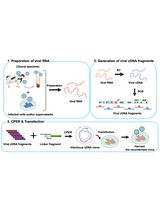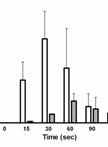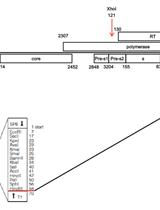- EN - English
- CN - 中文
Estimation of the Minimum Number of Replication Origins Per Chromosome in any Organism
任何生物体内每个染色体的最小复制起源点数目的估计
发布: 2020年10月20日第10卷第20期 DOI: 10.21769/BioProtoc.3798 浏览次数: 4119
评审: Raphael Souza PavaniNoelia LanderChangyi Zhang

相关实验方案

基于扩展型CPER的快速无质粒重组正链RNA病毒构建方法:适用于IRES介导翻译系统
Hirotaka Yamamoto [...] Takausuke Fukuhara
2025年04月20日 1985 阅读
Abstract
Eukaryote nuclear genomes predominantly replicate through multiple replication origins. The number of replication origins activated per chromosome during the S-phase duration may vary according to many factors, but the predominant one is replication stress. Several studies have applied different approaches to estimate the number and map the positions of the replication origins in various organisms. However, without a parameter to restrict the minimum of necessary origins, less sensitive techniques may suggest conflicting results. The estimation of the minimum number of replication origins (MO) per chromosome is an innovative method that allows the establishment of a threshold, which serves as a parameter for genomic approaches that map origins. For this, the MO can be easily obtained through a formula that requires as parameters: chromosome size, S-phase duration, and replication rate. The chromosome size for any organism can be acquired in genomic databanks (such as NCBI), the S-phase duration can be estimated by monitoring DNA replication, and the replication rate is obtained through the DNA combing approach. The estimation of MO is a simple, quick, and easy method that provides a new methodological framework to assist studies of mapping replication origins in any organism.
Keywords: DNA replication (DNA复制)Background
For all living organisms, DNA replication is a key and highly regulated process of paramount importance for biological inheritance. The first step of DNA replication is the establishment of the genomic loci, where DNA synthesis begins. These loci are called replication origins (or just origins) (Méchali, 2010). In general, the beginning of DNA synthesis occurs after an initiator binds to an origin and recruits specific proteins that will result in the formation of the replisome in a process called origin firing. Each origin fired generates two replication forks that move in opposite directions. Replication forks synthesize DNA at a velocity (rate) that varies according to the organism and cell lineage (Myllykallio et al., 2000; Stanojcic et al., 2016; da Silva et al., 2017). The time needed for all chromosomes to replicate determines the S-phase duration, which seems to be robust for certain cell types and organisms (Zhang et al., 2017; da Silva et al., 2020).
Although prokaryotes from the Bacteria domain usually replicate their genome using only one origin, the vast majority of organisms (Archaea and Eukarya domains, in general) replicate their chromosomes from multiple origins (Leonard and Méchali, 2013). However, the exact number of origins fired per chromosome can vary according to cell type and the cellular environment (da Silva et al., 2020). In a recent study (da Silva et al., 2019), I developed a formula capable of estimating the minimum number of origins (MO) required to duplicate an entire chromosome within the S-phase duration. The principle of the formula is the bidirectional movement of the replication forks. Moreover, the S-phase duration, the size of the chromosome in question, and the average replication rate are required as parameters of the equation.
The estimation of MO per chromosome is an innovative method that allows the establishment of a threshold, which serves as a parameter to assist (or validate) genomic approaches that map origins, such as marker frequency analysis coupled to next-generation sequencing (MFA-seq), small leading nascent strand purification coupled to next-generation sequencing (SNS-seq), DNA microarray, and DNA combing. Under standard conditions, MO values show minimal variation since the variables used in the formula are, in general, stable. The MO formula is universal and can be applied for any organism, even procaryotes. In the analyzes presented here, the trypanosomatid parasite Trypanosoma brucei was used as a model. In this organism, the protocol typically takes 2-3 days from the estimation of the variables to results. However, if the necessary variables are available (i.e., they can be obtained from other studies), the estimation of MO per chromosome can be carried out immediately.
Materials and Reagents
- Microtubes 1.5 ml (Axygen, Maxyclear, catalog number: MCT-150-C-S )
- Centrifuge tubes 15 ml (Corning, catalog number: CLS430791 )
- Culture flasks 25 cm2 (Corning, canted neck, cap plug seal, catalog number: CLS430168 )
- Syringe filter 0.22 µm (Sartori, Minisart Syringe filter, catalog number: 16534 )
- Micropipette tips (Axygen, 10 µl, 200 µl and 1,000 µl)
- Serological pipettes (Costar Sterile, 10 ml)
- Microscope Slides (Knitell glass, non-color)
- Coverslips (Knitell glass, 22 x 22 mm)
- Combicoverslips (Genomic vision, catalog number: COV-002-RUO )
- Reusable plug modes (from Molecular combing system–Genomic vision)
- 6-well flat-bottom plate (Costar, catalog number: 38015 )
- Plastic coverslips (use a cut plastic pocket for binder)
- Nail varnish (any brand, preferably colorless)
- Click-iT EdU Cell Proliferation Kit, Alexa Fluor 488 dye (ThermoFisher Scientific, catalog number: C10337 )
- 5′-Iodo-2’-deoxyuridine (IdU) (Sigma-Aldrich, catalog number: I7125 )
- 5′-Chloro-2′-deoxyuridine (CldU) (Abcam, catalog number: ab213715 )
- Mouse α-BrdU/α-IdU monoclonal antibody (BD, catalog number: 347580 )
- Rat α-BrdU/α-CldU monoclonal antibody (Accurate, catalog number: YSRTMCA2060GA )
- Goat α-mouse IgG1 secondary antibody, Alexa Fluor 568 (ThermoFisher Scientific, catalog number: A-21124 )
- Goat α-rat IgG (H+L) secondary antibody, Alexa Fluor 488 (ThermoFisher Scientific, catalog number: A-11006 )
- Paraformaldehyde (Sigma-Aldrich, catalog number: 158127 )
- Poly-L-lysine hydrochloride (Sigma-Aldrich, catalog number: P2658 )
- Bovine serum albumin (Sigma-Aldrich, catalog number: 0 5470 )
- Triton X-100 (Sigma-Aldrich, catalog number: T8787 )
- NaCl (Sigma-Aldrich, catalog number: S9888 )
- Na2HPO4 (Sigma Aldrich, catalog number: 255793 )
- Ethanol absolute (Merck Millipore, catalog number: 100983 )
- Vectashield Mounting Medium with DAPI (Vector Labs, catalog number: H-1200 )
- ProLong Gold Antifade Mountant (Thermo Fisher Scientific, catalog number: P36930 )
- Hydrochloric acid fuming 37% (Merck, catalog number: 100317 )
- Sodium hydroxide (Sigma-Aldrich, catalog number: 221465 )
- SDM-79 medium (LGC Biotecnologia, catalog number: BR30079-05 )
- Hemin (Merck, catalog number: H9039 )
- KCl (for molecular biology, any brand)
- KH2PO4 (for molecular biology, any brand)
- Fetal Bovine Serum (FBS) (Sigma-Aldrich, catalog number: F7524 )
- Streptomycin sulfate salt (Sigma-Aldrich, catalog number: S6501 )
- Penicillin G sodium salt (Sigma-Aldrich, catalog number: P3032 )
- EDTA·2H2O (Ethylenediaminetetraacetic acid disodium salt dihydrate) (Sigma-Aldrich, catalog number: E5134 )
- NaOH (ACS reagent, any brand)
- Ethanol (Absolute, Merck, catalog number: 100983 )
- N-Laurylsarcosine sodium salt (Sigma-Aldrich, catalog number: L5125 )
- Proteinase K (ThermoFischer Scientific, catalog number: AM2544 )
- Anti-DNA Antibody, single stranded (mouse anti-ssDNA) (Millipore, catalog number: MAB3868 )
- Goat anti-Mouse IgG2b Cross-Adsorbed Secondary Antibody, Alexa Fluor 350 (anti-mouse Alexa Fluor 350) (ThermoFischer Scientific, catalog number: A-21140 )
- MES, free acid (ULTROL grade, Calbiochem, catalog number: 475893 )
- Phosphate buffered saline (1x PBS) (see Recipes)
- Hemin Solution (HS) (see Recipes)
- SDM-79 medium (for cultivate T. brucei procyclic cells) (see Recipes)
- 5′-chloro-2′-deoxyuridine solution (CldU-S) (see Recipes)
- 5-ethynyl-2’-deoxyuridine solution (EdU-S) (see Recipes)
- 5′-iodo-2′-deoxyuridine solution (IdU-S) (see Recipes)
- 0.5 M EDTA (see Recipes)
- 0.65 M EDTA (see Recipes)
- 1.5 M Tris-HCl (see Recipes)
- 1 M NaCl (see Recipes)
- 70% ethanol (see Recipes)
- 90% ethanol (see Recipes)
- DNA combing washing buffer (DC-WB) (see Recipes)
- DNA combing lysis buffer (DC-LB) (see Recipes)
- DNA combing blocking solution (DC-BS) (see Recipes)
- DNA combing denaturation buffer (DC-DB) (see Recipes)
- DNA combing primary antibodies solution (DC-PAS) (see Recipes)
- DNA combing secondary antibodies solution (DC-SAS) (see Recipes)
- DNA combing anti-ssDNA solution (DC-anti-ssDNA) (see Recipes)
- DNA combing Alexafluor 350 (DC-alexa350) (see Recipes)
- T10E1 buffer (see Recipes)
- 0.5 M MES buffer (see Recipes)
- Fixation buffer (FB) (see Recipes)
- Poly-L-lysine solution (PLS) (see Recipes)
- Permeabilization solution (PS) (see Recipes)
Equipment
- Microcentrifuge (Eppendorf, model: 5424 R )
- Motorized pipet dispenser (Fisher Scientific, Fisherbrand, catalog number: 03-692-172 )
- Water bath (Cientec, model: CT-226 )
- Magnetic stirrer (Fisatom, model: 753A )
- Incubator BOD (Vitrex, model: NI1705 )
- Fluorescence Microscope [Olympus, model: BX51 , coupled to an XM10 digital camera. Filters specifications: U-MWU2 (excitation = 330-385 nm; emission = 420 nm), U-MWIBA3 (excitation = 460-495 nm; emission = 510-550 nm), and U-MWG2 (excitation = 510-550 nm; emission = 590 nm)]
- Micropipettes (Gilson, models: Pipetman P10, P20, P200, and P1000)
- Centrifuge (Eppendorf, model: 5810 R ), equipped with 4 x 250 ml Swing-Bucket Rotor
- Neubauer chamber with cover glass (Sigma-Aldrich, model: Bright-LineTM Hemacytometer )
- Biosafety Class II A2 cabinet (Pachane, model: PA 700 )
- pH meter (Gehaka, model: PG1800 )
- Autoclave (Tomy Seiko, model: SS-245 )
- FiberComb–Molecular combing system (Genomic Vision, model: MCS-001 )
Software
- CeCyD (Butantan Institute, published in da Silva et al., 2020, http://cecyd.vital.butantan.gov.br/)
- Doubling Time Calculator (2006) (version 3.1.0, https://doubling-time.com/compute_more.php)
- Olympus Cell F software (Olympus, version 5.1.2640)
- ImageJ (NIH, version 1.47t)
- Microsoft Excel (Microsoft Office-any version) or GraphPad Prism (GraphPad software, Inc.)
Procedure
文章信息
版权信息
© 2020 The Authors; exclusive licensee Bio-protocol LLC.
如何引用
da Silva, M. S. (2020). Estimation of the Minimum Number of Replication Origins Per Chromosome in any Organism. Bio-protocol 10(20): e3798. DOI: 10.21769/BioProtoc.3798.
分类
微生物学 > 微生物遗传学 > DNA > DNA 复制
分子生物学 > DNA > DNA 合成
您对这篇实验方法有问题吗?
在此处发布您的问题,我们将邀请本文作者来回答。同时,我们会将您的问题发布到Bio-protocol Exchange,以便寻求社区成员的帮助。
Share
Bluesky
X
Copy link












